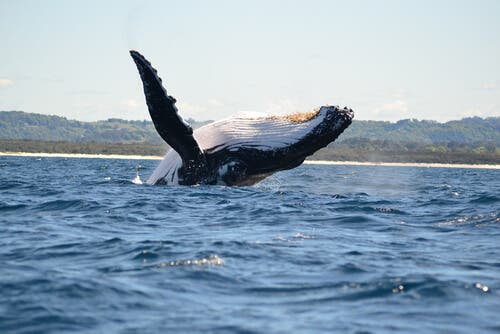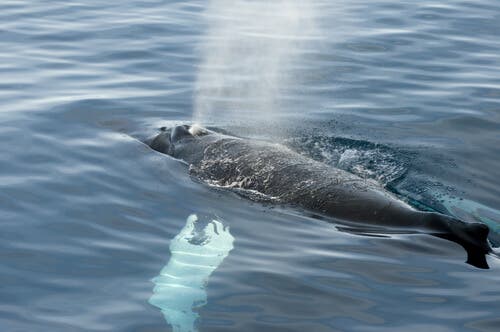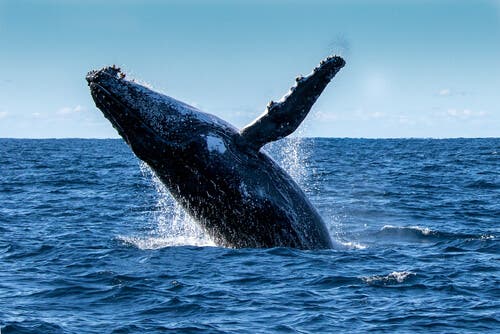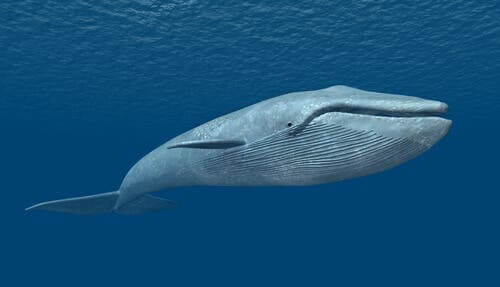The Great Cetaceans of Our Planet

The great cetaceans of our planet are a group of aquatic mammals formed by some 80 species of varying sizes. In our oceans, we find two subgroups or cetaceans, or parvorders. First, we have the Odontoceti, which have teeth, and also the Mysticeti, which possess a filter-feeder system.
The origin of cetaceans goes back from 55 million years. And during this tremendously broad period of time, a great number of families have become extinct.
A classic example of cetaceans is the dolphin. However, today we want to talk about the great cetaceans, some of the largest beings that have ever existed on our planet.
The body of the great cetaceans
Cetaceans are marine mammals that have the shape of fish. They possess two front fins, which are the remains of the front feed that belonged to their non-aquatic ancestors.
At the same time, their back legs have disappeared and they have an enormous back fin. They also possess a dorsal fin, which is located on their backs. Depending on the species, you can recognize them simply by the shape of their dorsal fin.
Another interesting fact that’s worth mentioning is that, when they’re born, their young have a small amount of hair. However, they quickly lose it as they grow. It’s also important to point out two other characteristic features of the great cetaceans.
First, all cetaceans have a layer of fat below their skin that protects them from cold ocean temperatures. At the same time, on the top of their heads, they have an orifice—called a spout, or blowhole–that allows them to breathe.

Suborders of cetaceans
As we’ve already mentioned, there are currently two parvorders of the cetacean order: Mysticeti and Odontoceti. Mysticetes don’t have teeth, but have stringy barbs in their mouths. As an example, we can mention the blue whale.
Members of this subgroup–also known as baleen whales–are carnivores. However, they don’t hunt large prey. Their hunting techniques allow them to feed by filter or by lunging. Either they filter their food from the water through their baleen plates, or they corral their prey and swallow them, respectively.
Odontocetes are cetaceans that do possess teeth. For example, we can mention orcas in this group. This subgroup is also carnivorous. Orcas feed not only on fish and marine animals but also on birds, seals, etc. They are great predators and, depending on where they live, they hunt different types of prey.
These two subgroups utilize a variety of hunting techniques and can even hunt in groups. Humpback whales, for example, flap their tail fins as a group in order to create whirlpools and bubbles. This confuses fish, which inevitably end up finding themselves in the mouths of these great cetaceans.
Orcas, for their part, corral the schools of herring on the coast, producing sounds to confuse them. This allows them to gather the schools into a more compact space in order to gobble them up.
Localization and the social life of great cetaceans
Different species of cetaceans spread throughout all of the oceans on planet Earth. In fact, there are even some freshwater species that live in lakes and rivers. Some of our great cetaceans, like orcas and blue whales, travel around the world. While others, like the vaquita of California, live in one specific area and never leave it.
Many baleen whales make enormous migrations that are thousands of miles long. For example, the humpback whale spends most of its life in the polar regions. However, in the winter, it travels to Ecuador in order to mate and give birth.

Just how our great cetaceans are able to get their bearings in order to travel such long distances remains a mystery. Experts speculate that they may use the Earth’s magnetic field as a guide, or perhaps they follow marine currents.
Species of great cetaceans
Cetaceans vary greatly when it comes to size. For example, the blue whale is the largest animal to ever exist and is even bigger than the dinosaurs. At the same time, we have dolphins, which are about the same size as a human being. The largest cetaceans are :
- The pygmy right whale is the smallest of the whales. These animals are hard to locate and we know very little about them. However, experts estimate they measure around 20 feet and weigh some three and a half tons.
- The humpback whale can measure up to about 52 feet and weight some 36 tons. They move throughout all of the oceans and only feed during the summer in the regions of Ecuador. This species isn’t in danger of extinction, especially thanks to a surge in whale watching and the close vigilance of its populations.
- The bowhead whale lacks the dorsal fin that’s so typical to the rest of the cetaceans. It can measure up to nearly 60 feet and weigh some 100 tons. These whales are grey or black and have white spots under their heads and around their tail. They live in the polar oceans in the north of our planet.
Species of gigantic cetaceans
- The Basilosaurus is an extinct species of cetaceans. Experts believe that these animals lived in all oceans and were unable to withstand long periods of time underwater. They measured an estimated 50 to 60 feet long and could weigh between 60 and 80 tons. In their time, they were the largest animals in existence.
- The sperm whale is the animal with the largest brain. It’s also the largest predator to exist and produces the strongest sound emitted by any animal. Sperm whales can measure some 65 feet and weigh up to 57 tons. They are found in waters in any part of the world, but they prefer tropical and subtropical regions. The actual size of the sperm whale population is unknown, but they’re in slight danger of extinction.

- As far as we know, the blue whale is the largest animal to ever exist. These great cetaceans can measure up to 88 feet long and weigh up to 120 tons. In fact, there are records of specimens measuring over 98 feet and weighing 170 tons.
Unfortunately, whaling boats brought the blue whale to the brink of extinction at the beginning of the 20th century. Today, the hunting of these animals is illegal and, fortunately, their populations are recovering thanks to protection laws.